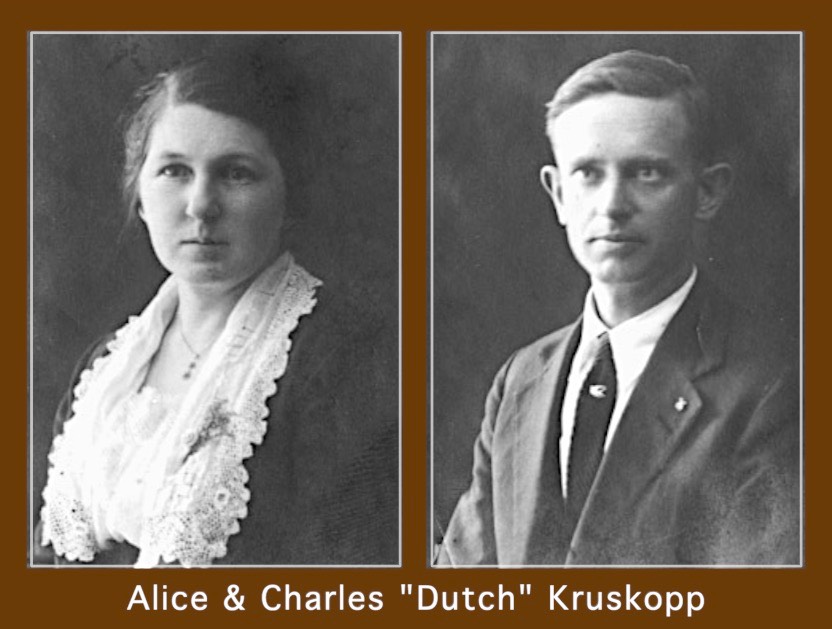Frankly, I haven’t heard of a single unsolved homicide in the Lovewell family per se. However, a sinister story has trickled through generations of the descendants of Julany Lovewell, the young lady appearing alongside her father in the banner at the top of the page. The story concerns a grim occurrence in the town of Lovewell during the final decade of 1800’s. It might have been a terrible accident or perhaps a cruel trick that got out of hand, but at the time the victim and her sister believed it was a case of attempted murder.
I only know the gist of the tale because of a conversation I overheard at my grandmother’s house in 1959. It was probably late August because a TV set in another room was blaring out a promo for a brand new series that would premiere in September on NBC, called Bonanza. For a few weeks that summer TV viewers were teased with the spectacle of two hotheaded Cartwright boys, played by Pernell Roberts and Michael Landon, punching and flinging each other around the vast family room of a Nevada ranch house as their sibling rivalry erupted into a no-holds-barred brawl.
Meanwhile, in the kitchen pantry of a modest cottage twenty yards from the railroad tracks at Formoso, Kansas, Grandma Logan and Aunt Alice, reminisced about the hard knocks of their youth.
Grandma asked, “Remember when we first came to Kansas, Sis?” “Oh yes,” the former Alice McCaul moaned, shaking her head. Her voice rose sharply as she added, “and that Lovewell girl tried to kill you!” That’s when I started paying less attention to the television and began to concentrate on the conversation in the pantry.
Visits from my aunt and uncle, Alice and Charles “Dutch” Kruskopp, were rare occasions during the time I knew them. They lived 500 miles away in Fort Smith, Arkansas, where “Dutch” had worked at an auto garage, a zinc smelter, and a glassworks. He was a wizard with machinery and was always consulted when anyone in the family was looking for a reliable car. The Kruskopps may have made the journey north more frequently in previous decades, but they were in their seventies when I knew them. By that time “Dutch” had lost all of his teeth, didn’t care for dentures so never wore them, and Alice’s left arm hung in a sling because of a fracture that failed to knit.

Reputedly, Alice had been no Julia Child before her accident and gave up any effort to broaden her cooking skills afterward. “Dutch” was just as happy living on a diet of fried smelt and limburger sandwiches, and there was always that Worldburger joint just up the street in Fort Smith, famous for a hamburger the size of a dinner plate.
During the conversation overheard in 1959 I gleaned a few details of the efforts of “that Lovewell girl” to eliminate my grandmother, enough to form a mental image of someone serving her a bowl of porridge laced with shards of broken glass.

Fifty years after hearing that conversation I placed a call to my cousin Nancy to validate the story. Nancy was twelve years old when I was born and thus knew more tales of our grandmother’s youth, most of them involving desperate poverty in a St. Louis slum. During that same call she would inform me about the mysterious “Auntie Sherman” whose vocation was depression-proof and whose generosity kept the McCaul family from starving during the early 1890’s. About the incident with the porridge she did add a salient fact: When Thomas Lovewell found out about the incident he blew his top.
So, just who might have been that Lovewell girl of family legend and what form did the wrath of Thomas Lovewell take? I began to pursue leads.
According to the 1895 Kansas Census, Lilly Robinson and Alice McCaul had moved in with Thomas and Orel Jane Lovewell around the time their mother, Julany (Lovewell) McCaul-Robinson, died of cancer in 1894. At that moment there were only two Lovewell daughters still living in their parents’ home. The school portrait of their 14-year-old daughter is the picture of a perfect angel who would soon marry into a prosperous local family. Her younger sister was another story.
In 1899 when she was only 15 years old, the youngest daughter would slip across the state line into Nebraska and claim to be 18, old enough to marry her boyfriend without parental consent. This was probably necessary because the young man was a convicted felon. For years to come whenever she wished to return to Kansas to visit her parents, she was forced to travel alone because of a legal cloud still hovering over her spouse: an outstanding warrant for attempted murder.
As family mysteries go, this seemed to be an easy one to crack.
However, as I thought further about the two Lovewell girls, I remembered that 1895 was also the year when the angelic 14-year-old suddenly boarded a train bound for Dodge City where she planned to move in with a married sister who was nearly a decade older.
Could her flight from Lovewell be connected to my grandmother’s story? Had Thomas Lovewell banished her from his home or at least sent the girl away for a cooling-off period? When you’re looking for suspects, any sudden move can seem suspicious.
I put my deerstalker cap and magnifying glass away for a moment, realizing that there were more mundane explanations for a young lady's trip to Dodge. What may have needed cooling off was a budding romance with that young man she would wed less than a year after returning home to Lovewell, and a whole five months after turning 15.
Picking up the magnifying glass once more I thought her little sister still looked good for the crime. She had always been the baby of the Lovewell household. Then at age 11 her world was suddenly turned upside-down by a 7-year-old upstart she had never even heard of before, a rival who dropped in out of nowhere and became the center of attention.
It seemed like an ironclad open-and-shut case to me, even though based entirely on circumstantial evidence and imaginary motives. Hmm. Perhaps Cousin Nancy had provided additional clues that would make the case stick. It was time to check the notes from our conversation more than a decade ago.
What I saw scribbled on the notepad reminded me why I had put off taking a hard look at this story. The notes from our conversation revealed a rat’s nest of complications. For example, the perpetrator was thought to be in cahoots with a shady banker from Superior who was scheming to defraud my grandmother out of money left in trust for her by her father, the mysterious John W. Robinson. In fact that may have been the tipping point that ignited Thomas Lovewell’s temper.
John W. Robinson was still living in Lovewell when the Kansas Census was taken in 1895. The porridge incident may have happened a year or two later than I first imagined. According to a family legend Robinson was found dead under mysterious circumstances at a building site near the Kansas City Stockyards, where he was overseeing an important construction project.
How did John W. Robinson suddenly become a big-shot contractor doing business in a major city on a grand scale? He had been a locomotive engineer driving rail cars across Nebraska during his marriage to Susan Turnbull in the early 1880’s. He worked in the local coal mines when he was hanging out with Julany McCaul and the Turnbulls in Carbondale, Kansas, and then went back to being an engineer when he came to Lovewell with his ailing wife. After 1895 we simply don’t know where he was or what he was doing.
If foul play was suspected in his disappearance, Orel Jane Lovewell hadn’t heard about it. According to her 1923 pension statement, Mr. Robinson moved away after his wife’s death, and Orel Jane had no idea where he went or whether he might still be living.
My grandmother may have chomped down on something sharp and gritty at the breakfast table one morning in her youth, but was it really part of a plot dreamed up by a mustache-twirling villain out of a 19th century melodrama? The story I related at the top of the page is a memory that has been simmering in my brain for 64 years. It had been simmering for a similar amount of time in someone else’s before I first heard it. The story has become intertwined with two familiar tropes from family histories: the tale of the lost fortune, and the untimely death in a distant place, usually told to explain a father’s absence.
Some mysteries should simply be appreciated as mysteries. This one probably wasn’t meant to be solved.